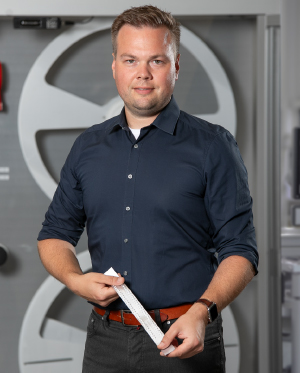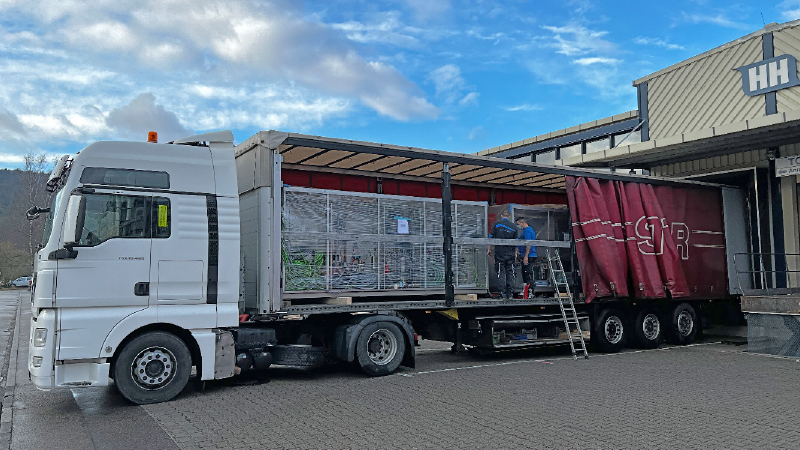Mr. Jung, what did the conversion project involve?

Benjamin Jung, Account Manager Customer Service at Harro Höfliger, accompanied the MSP modernization.
Sustainability and the responsible use of resources are becoming increasingly important. This also includes using machines for as long as possible and yet keeping them fit for the future. As Customer Service, we deliver a wide variety of customized solutions to extend the lifecycle of the line or adapt it to new requirements. Modernizations and upgrades of every kind, from retrofits to complete machine conversions, are included, of course. Rebuilding the MSP − a machine for filling blisters with inhalation powder − of AEROPHARM GmbH was the biggest project of its kind that we had implemented in Customer Service to date.
What was specifically required?
The MSP with drum dosing system had served reliably for years, filling blister strips for a dry powder inhaler with powder containing active ingredient. Due to a product changeover, our customer had taken the line out of service some time previously. I’ve served this pharmaceutical company for about 15 years in various roles at Harro Höfliger. Over a cup of coffee, Pierre Solcher, Head Service & Qualification, and Dr. Sebastian Moritz, PD Group Head, and I got to talking about whether it would be possible to breathe new life into the line with a new filling system and retrofitting options. It turned out to be possible!
How did you go about it?
My colleagues and I took a close look at the requirements. The line consists of three modules: for forming, filling/sealing and for cutting. With the conversion of three drum fillers to a new dosing system, it was necessary to completely replace one module and modify the other stations. At the customer’s request, space was also to be created inside the containment for an optional X‑ray system for filling control − this meant extending the line by 1.5 meters. For dosing, we had one of our other filling principles in mind, which was established on the market and was in a position to meet the special requirements of AEROPHARM GmbH. In order to determine whether this represented the best dosing solution for the product and which format parts were required, we proceeded in much the same way as we do with a new machine and had our Pharma Services carry out powder analyses and filling experiments with active material in the cleanroom.
“Already during the initial project phase, it was clear that we needed a competent partner to help us implement the complex project requirements. So we turned to Harro Höfliger with whom we have a long-standing business relationship. It didn’t take long before the idea of upgrading an existing machine was born, knowing full well that this wasn’t going to be an easy task and would involve a certain amount of effort. In summary, it’s true to say that it was the right decision.”Pierre Solcher,
Head Service & Qualification,
AEROPHARM GmbH
Where did the conversion take place?
A logistics company brought the line back to Allmersbach to the plant in which it had once been constructed. Project management was in the hands of Customer Service and we accomplished the design, installation, electrical installation, control engineering and technical documentation with our own resources. But of course we worked hand in hand with the various specialist departments on-site, for instance with regard to validation, containment or camera control. After commissioning and the factory acceptance test in our production plant, the site acceptance test was also completed successfully at the facility of our customer, with whom cooperation had been excellent.
Were there any other changes besides the new stations?
The MSP was converted in this process to a more advanced control technology − from PacDrive M to PacDrive 3 − and the operating system was upgraded from HMI 1.0 to 2.0. This gives our customer the assurance of being able to use their line for many years to come without any potential problems with discontinued components, a matter particularly close to our hearts in Customer Service.
Which advantages, beyond assured spare parts, does a conversion offer?
Conversion or retrofitting, in which a machine is improved or reconfigured to meet current requirements, is a sustainable, future-proof alternative to purchasing new and often entails lower investment costs. Apart from the complex measures on the MSP as described, the majority of the line remained unaffected. The extended service life of a machine not only saves on resources, but also usually reduces the effort required for the customer to retrain the operating personnel, as the familiar basic functionality remains. Giving a line a second life, so to speak, inspires me and our experts from Customer Service every time anew.
“The overall concept convinced us not only in terms of the economical use of resources, which also plays an enormously important role for us. We received competent support from Harro Höfliger in all project phases and the work was always solution-oriented. We’re looking positively to the future and are well equipped for upcoming challenges.”
Dr. Sebastian Moritz,
PD Group Head, Pharmaceutical Development,
AEROPHARM GmbH
Download this article as PDF file
Photos: AEROPHARM GmbH, Helmar Lünig



